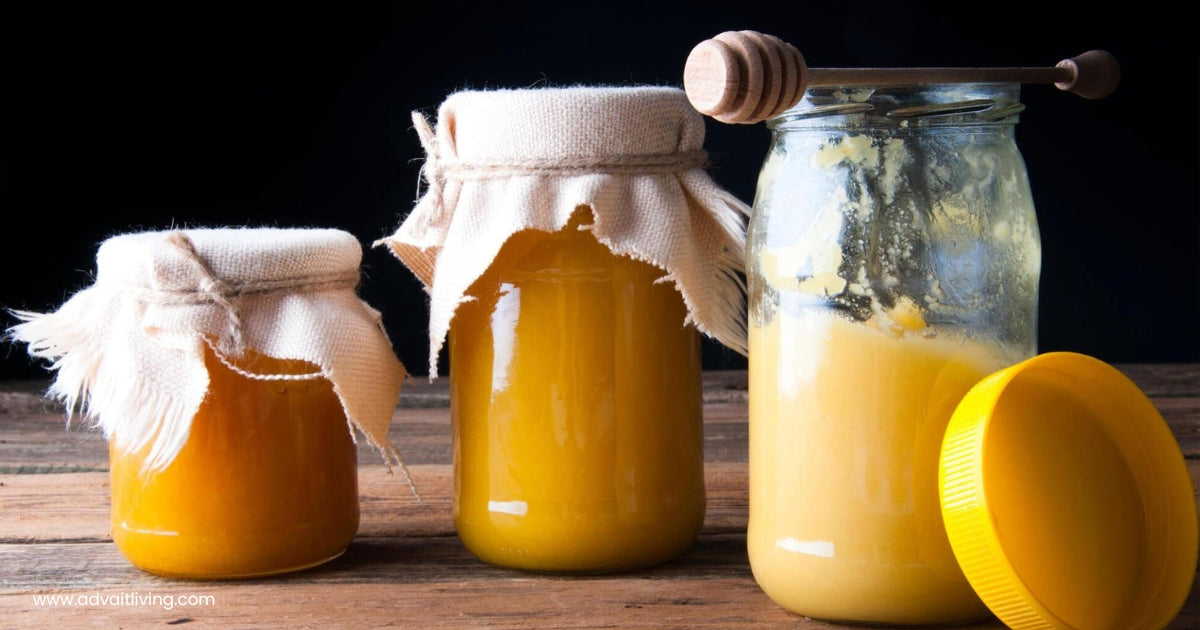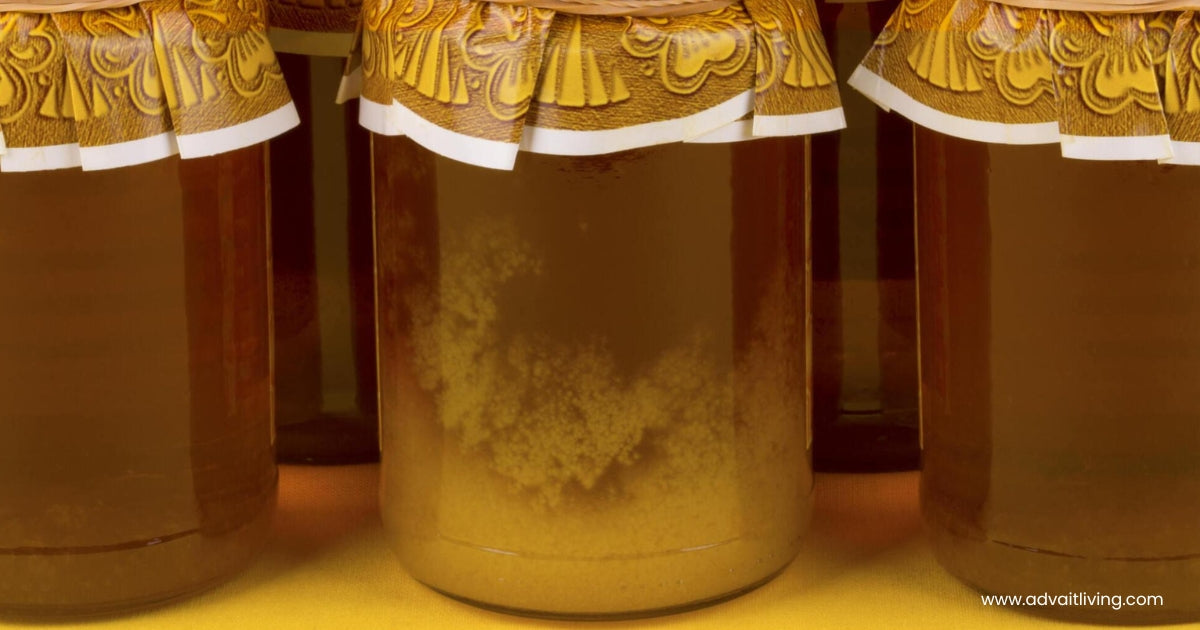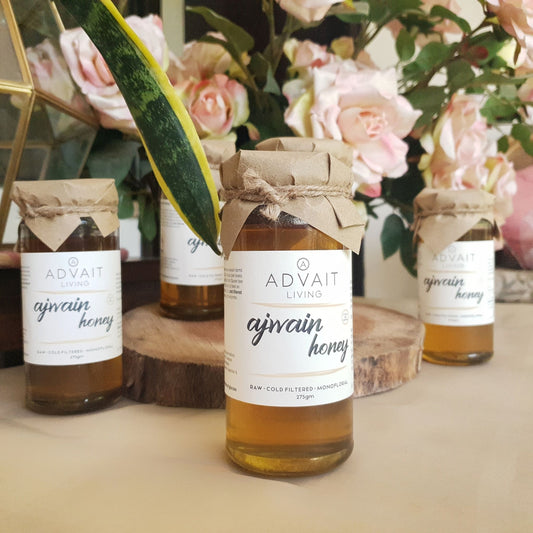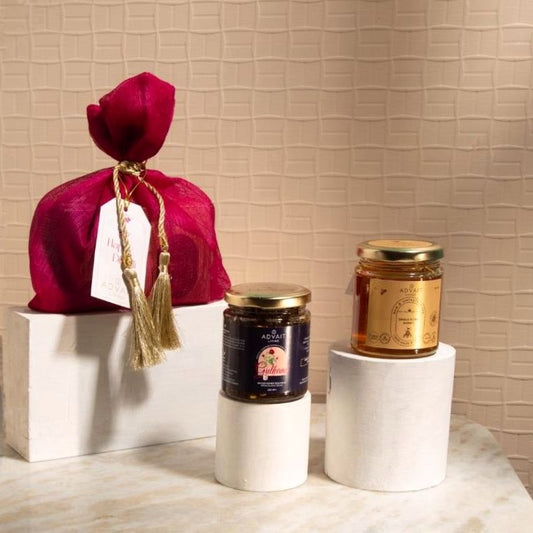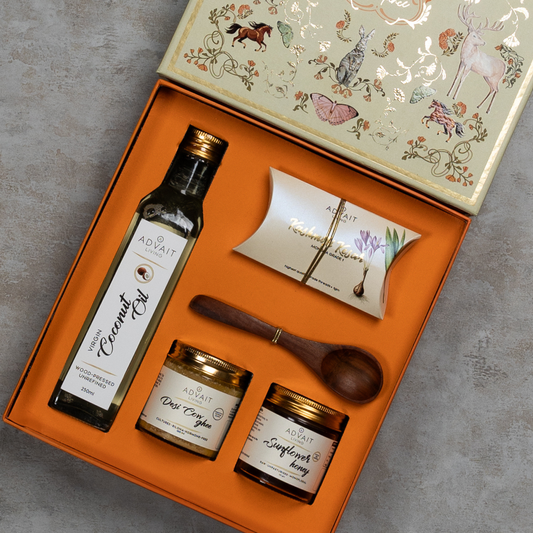Crystallisation is the formation of sugar-like crystals in the honey bottle! Don't be alarmed. Crystallisation is perfectly normal and a natural process in raw honey. And it will not cause any change in the nutritional value of the honey. Unlike commercial honey, which doesn't crystallise, raw honey will crystallise. In fact, the crystallisation of honey is a guarantee that it is pure and natural.
What is Crystallisation of Honey?
The formation of sugar crystals in the honey container is known as the crystallisation of honey. This crystallisation process is natural and spontaneous and does not alter any qualities of the natural honey except for colour and texture. As pure honey is a supersaturated solution, it tends to crystallise over time or with changes in room temperature during storage. Crystallised honey is, in fact, an indicator of pure and unadulterated honey.
Characteristics of Crystallised Honey
The texture of the crystallised honey is opaque and waxy in appearance. Some honey crystallises uniformly throughout the bottle, whereas others partially crystallise, leaving the top layer in a liquid form. The size of the crystals varies from one type of honey to another, depending on the speed of honey crystallisation. The faster the honey crystallises, the finer the crystals are.
For example, Mango honey undergoes crystallisation at a rapid rate and forms finer crystals. Sunflower and Ajwain honey crystallise at a very slow rate and form medium-sized crystals. On the other hand, lychee honey (from Bihar) does not crystallise and if it ever does, it does so at an extremely slow rate.
Another interesting thing is that honey does not crystallise within the honeycomb. The absence of moisture, dust, microbes, and other contaminants makes it hard for the honey to crystallise inside the honeycomb.
Nonetheless, crystallised honey is safe to consume and retains the high nutritional value of raw honey.
Factors Influencing Crystallisation of Honey
The crystallisation of honey is influenced by various factors like the ratio of fructose/glucose and glucose/water, changes in temperature and pollen content and more. Here are four main factors that impact the honey’s tendency to crystallise.
1. Ratio of Fructose/Glucose
Raw honey contains two major sugar groups called fructose and glucose in water. One of the factors influencing crystallisation is the ratio of fructose/glucose in the honey.
Fructose levels higher than 1.3 (to glucose) in the honey lead to slow crystallisation of honey (honey does not crystallise for a longer period), and a ratio higher than 1.58 exhibits no crystal formation. On the flip side, the ratio less than 1.11 leads to faster crystallisation of honey. This is because fructose is more soluble in water and delays the process of crystallisation.
On the other hand, glucose is less soluble in water and increases the rate of honey crystallisation. This is due to the precipitation of glucose into glucose monohydrate (the stable form under ambient conditions), which quickens the crystallisation rate. Hence, the honey with higher glucose than fructose will crystallise faster.
Mustard honey from India is the king of crystallised honey from this region. The fructose/Glucose ratio is less than 1.11 (meaning the concentration of glucose is higher than fructose), leading to the faster crystallisation of honey. In fact, mustard honey tends to crystallise within weeks of harvest.
In contrast, the higher concentration of fructose in sunflower honey slows down the crystallisation and maintains it in liquid form for a longer period.
2. Ratio of Glucose/Water
The ratio of glucose/water is an excellent factor in indicating the crystallisation of honey. When the concentration of glucose is higher than water, the rate of crystallisation of honey increases. The ratio of G/W in honey less than 1.7 indicates slow crystallisation, whereas the ratio greater than 2.0 indicates fast and complete crystallisation.
Every honey with a glucose concentration lower than 30% is slow or doesn’t undergo crystallisation, except ‘field cabbage’ honey. Despite the low glucose content (26.4%) and G/W ratio of 1.45, field cabbage honey exhibits rapid crystallisation.
3. Changes in Temperature
Crystallisation also occurs faster at lower temperatures. The ideal temperature for honey to start getting crystallised is between 10 to 15℃. In these lower temperatures, glucose gets separated from the water and forms fine crystals and coarse grains, leading to crystallisation. And that is why keeping raw honey in the fridge will produce crystals in your honey.
4. High Pollen Content
Another factor that influences rapid crystallisation is the presence of pollen flecks in raw honey. Pollen behaves as a natural crystallisation centre, and crystals tend to begin growing around the pollen.
Moreover, the absolute pollen count indicates the degree of crystallisation.
It determines the crystal size and also influences the rate of crystallisation. The presence of a high number of nuclei (crystallisation centres) makes the honey crystallise faster.
However, rapid crystallisation comes with a high number of crystals in a fine, smaller size with a compact structure. In contrast, the slow crystallisation process has less number of crystals and produces thick, non-compact, structured crystals.
Crystallisation of Raw Honey
Raw honey is collected directly from the bees and does not undergo any artificial processing. Hence, it retains its natural fructose/glucose or glucose/water ratios, and it usually preserves its natural pollen, enzymes, and other biominerals intact. These factors influence the crystallisation of raw honey.
However, each raw honey will have its own distinct characteristic that will affect its tendency to crystallise, the speed or rate of crystallisation and the size of the crystals. Different raw honey will have varied crystallisation characteristics.
For example, Raw mustard honey is a jam-like honey with uniform crystals throughout the honey. Even raw floral honey, such as mango honey, coriander honey and dill honey, all tend to crystallise fast and have distinct colours and textures.
On the other hand, raw floral honey such as sunflower, ajwain, acacia and tulsi honey tends to crystallise at lower temperatures and over a longer duration of time. Some raw honey, such as lychee honey, may not crystallise at all.
Crystallisation of Processed Honey
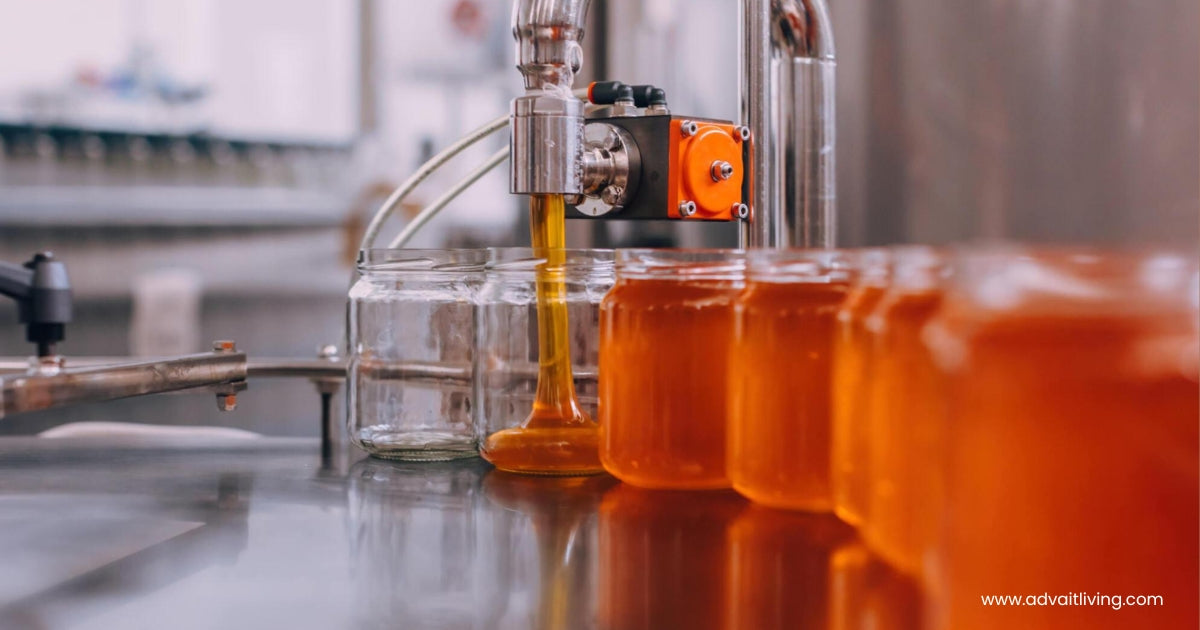
Processed honey has undergone several processes that change and shape its desired characteristics. One of the desired traits of processed honey is a ‘longer shelf life’. Prevention of crystallisation of honey contributes to improved shelf life of honey.
Prolonged crystallisation may lead to the possibility of yeast formation in the honey, thus affecting its shelf life. This is due to increased water activity over time that can activate and promote yeast/mould to form in the honey. Hence, it is an undesired outcome for shelf-stable honey.
To increase the shelf life and prevent crystallisation, processed honey undergoes methods like heat treatment at high or very low temperatures, ultrasound treatment, filtration, and ultrafiltration. During such treatments, crystallisation centres like pollen particles, glucose crystals, and anything that stimulates crystallisation are removed.
Recent studies show that the usage of additives like trehalose (a non-reducing sugar) may also prevent crystallisation without altering the colour of the honey.
When honey is crystallised under controlled conditions, the shelf-life and quality of honey can be improved. However, in an attempt to delay crystallisation using extensive heat and filtration, the honey loses its nutritional value.
Myths about Honey Crystallisation
Consumers often misinterpret crystallised honey as an adulterated product when, in fact, the opposite is true. Crystallised honey is never a sign of spoilage or any adulteration. Rather, it indicates the purity of honey because only pure honey crystallises. Furthermore, it is also evident that there are no changes in the nutritional value of honey after crystallisation.
Conclusion
In conclusion, the crystallisation of honey is a natural and inevitable process of pure honey. This process does not alter the nutritional value but involves changes in the colour and texture of the raw honey. It is also evident from the factors influencing the crystallisation of honey, such as sugar composition, moisture composition, temperature and pollen content, that this process is a sign of purity and authenticity.
While processed honey does not undergo crystallisation, it comes at the cost of reduced nutritional value.
Hence, raw honey is highly recommended for individuals looking for a higher nutritional value in honey.
Frequently Asked Questions
1. Is it Safe to consume crystallised honey?
Yes, crystallised honey is absolutely safe to consume. It is a natural process that occurs in raw honey over time. In crystallised honey, there is no change in the nutritional value of raw honey, and it is not a sign of spoilage. So, adults can consume it without any hesitation.
2. How do you stop honey from crystallisation?
You can stop honey from crystallisation by storing it at room temperature. As cold temperature increases the rate of crystallisation, avoid storing it in the refrigerator. Make sure to store it in glass jars to prevent the entry of moisture.
3. Does fake honey crystallise?
No, the fake or adulterated honey never crystallises. It usually contains sugar syrups or high fructose corn syrups, which do not form any crystals.
4. My raw honey has crystallised. How can I return it to its normal form?
Raw crystallised honey can completely get back to its normal form. Boil some water in a pan. Let it cool a bit. Put your glass jar of honey in the warm water till your honey starts to return to normal form. This will allow the honey to return to its normal character without losing any beneficial properties.



